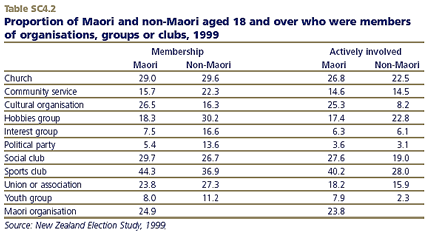Social Connectedness
OUTCOMES
People enjoy constructive relationships with others in their families, whānau, communities, iwi and workplaces. They are able to participate in society and have a sense of belonging.
INTRODUCTION
Social connectedness is a way of describing the relationships people have with others and the benefits those relationships bring to the individual as well as to society.
It includes informal relationships with family, friends, colleagues and neighbours, as well as relationships people make through participating in sport or other leisure activities, paid work, or through contributing to their communities through voluntary work or community service.
Relationships can be a source of fun and support. They help people to feel that they belong, are included and have a part to play in society. People who feel socially connected also contribute towards building communities and society. They help to create what is sometimes called "social capital", the networks that help society to function effectively.
Social connectedness is fostered when family relationships are positive, and when people have the skills and opportunities to make friends and to interact constructively with others. Good health, employment, and feeling safe and secure all increase people's chances of developing positive relationships. For some, lack of English can be a barrier to connectedness with groups wider than those who share their own language.
The measurement of social capital is at a very early stage of development. Current indicators do not necessarily capture informal, as well as formal, relationships. Nor do they adequately measure the quality of those relationships. These are areas for future development. The indicators in this report measure people's involvement in voluntary work, how often people are in regular contact with family and friends, their access to the telephone and Internet in their homes, and club or group membership.
Time spent on unpaid work outside the home is an indicator of people's willingness and ability to act for others and to enhance the common good. It has benefits for both worker and recipient. Involvement in clubs and organisations is another way in which people interact with the wider community. Personal networks are an important source of support and the extent of contact between family and friends is an indicator of the strength of those networks. The telephone and Internet allow people to keep in touch from a distance. The Internet also allows ready access to a wide range of knowledge and information and is important for participation in the knowledge society.
KEY POINTS
- Sixty three per cent of women engage in unpaid work outside the home compared with 55 per cent of men. Women are more likely than men to spend time caring for people outside their household and providing services, whereas men and women spend similar amounts of time on unpaid administration for organisations. People who receive income-tested benefits spend more time on unpaid work than other people, as do people who are not in full-time work. Māori are more likely than non-Māori to undertake unpaid work outside their home and on average spend more time on it. There are a number of reasons why people do not do voluntary work. Some people simply do not have time to engage.
- Telephone access in homes is high at 97 per cent overall. Four groups have lower than average access. They are Māori and Pacific families, sole parent families and families where the main income earner is not in full-time employment. Internet access in the home is much more variable. Fewer than half the population as a whole, 41 per cent, currently have access to the Internet in their homes. The proportions are much lower for adults over 65, Māori and Pacific families, sole parents and families where the main income earner is not in full-time employment.
- Participation in family/whānau activities is very common, with 87 per cent of the population engaging in such activities. Māori have particularly high rates at 91 per cent. At 72 per cent, people from "Other" ethnic groups have the lowest level of participation. This group is likely to include a high proportion of new migrants whose families live elsewhere. Participation is also low for adults over 65 who have little or no income above New Zealand Superannuation, suggesting that income is a factor for this group. Sharing a meal with family or friends is also a common activity, with 71 per cent of the population doing this at least once a month. The figure rises to 80 per cent for Pacific families, underlining the importance of family contacts for this group.
- In 1999, many New Zealanders aged 18 and over belonged to an organisation, group or club. Sports, hobbies, church and union groups attracted the highest membership. Most members were active participants. Women were more active in church and hobby groups than men, who favoured sports clubs and unions. Māori had higher rates of involvement than non-Māori in sports clubs and cultural organisations. Nearly one in four Māori belonged to a cultural organisation.
SUMMARY
While some information is available on how often people have contact with others, socially or through unpaid work, there is no information on the quality of these relationships. Detailed information for different ethnic groups is lacking in some areas, as is data on trends over time.
The information that is available suggests that a high proportion of the population participate in family activities, clubs and groups, and unpaid work outside the home. While Māori and Pacific families have lower than average levels of access to the telephone and Internet in their homes, they are active in groups and maintain high levels of face-to-face contact with family. They are also more likely to provide care for non-household members.
Low income appears to be a barrier to maintaining social contact for some groups. While there may be some element of choice in relation to using the new technology, barriers to access may have wider ramifications in terms of skills and access to information and knowledge.
Unpaid work outside the home
DEFINITION
The proportion of the population aged 12 and over who did unpaid work for people or organisations outside their own household, and the average time spent on unpaid work outside the home, as measured by the 1999 Time Use Survey.
RELEVANCE
Spending time on providing services and support to others without financial reward is one of the ways in which people build and maintain social networks that help society to function effectively.
CURRENT LEVEL (NO TREND DATA AVAILABLE)
The survey found that 59 per cent of New Zealanders aged 12 and over spent some time during the previous four weeks doing unpaid work for people or organisations outside their own home. Overall, people spent an average of 48 minutes doing unpaid work outside the home each day, including 29 minutes in which it was their main activity. An average of 14 minutes per person aged 12 and over was spent on unpaid work for community organisations. Slightly more time was spent on informal unpaid work, such as caring for and helping people from other households.
AGE AND GENDER DIFFERENCES
Women are more likely than men to do unpaid work outside the home (63 per cent compared to 55 per cent). They also spend more time on this work than men. In part, this reflects their lower rates of paid employment.
Women on average spend more time than men caring for people outside their household and providing services such as meals on wheels and parent help at school, but the same amount of time on unpaid administration for organisations.
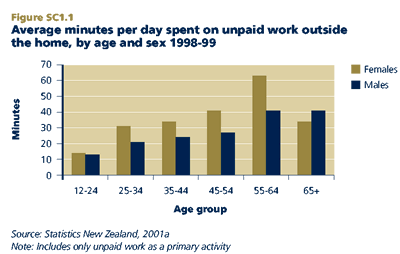
Gender differences are greatest at ages 55-64, with women spending 1.5 times as long as men working for others. In the 65 and over age group, the reverse is true, with men spending more time than women on unpaid work outside the home. Men and women who are employed full-time spend the least time in unpaid work for others. Women, part-time workers and men who are unemployed spend the most time in unpaid work. People who receive income-tested benefits spend more time on unpaid work than other people. Rural women and men also spend longer on unpaid work outside the home than nonrural people, reflecting the importance of social networks and voluntary work in the functioning of the rural sector.

ETHNIC DIFFERENCES
Māori are more likely than non-Māori to undertake unpaid work outside their own home, and on average spend more time doing so. The difference is evident across all age groups, peaking among those aged 45-54 years.
In particular, Māori spend more time providing assistance and care for non-household members, perhaps reflecting the traditional role of the wha-nau in caring for extended family members.
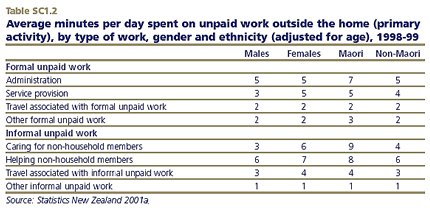
Telephone and Internet access in the home
DEFINITION
The proportion of the population with telephone and Internet access in the home, as measured by the 2000 Living Standards Surveys.
RELEVANCE
Being able to communicate and interact easily in the absence of frequent face-to-face contact helps maintain social connectedness. Access to telephones and access to communication via the Internet, especially e-mails, are particularly relevant as social indicators because access to mail services is almost universal and fax use is principally by businesses. The Internet also facilitates access to a significant and growing repository of information and knowledge.
CURRENT LEVEL (NO TREND DATA AVAILABLE)
Access to a telephone is almost universal in New Zealand, at 97 per cent overall. Internet access within the home is also relatively high, at 41 per cent, considering the relatively recent introduction of this communication technology.
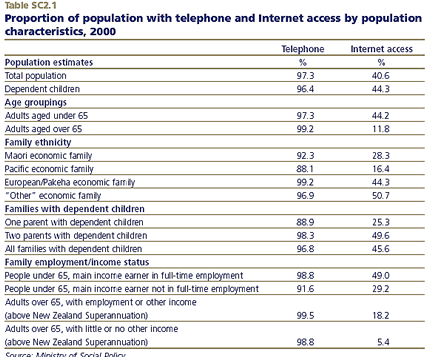
ETHNIC DIFFERENCES
People living in Pacific economic families (those with any Pacific member) have the lowest telephone and Internet access in the home (88 per cent and 16 per cent, respectively), followed by people living in Māori economic families (92 per cent and 28 per cent). The highest level of Internet access in the home was observed among people living in "Other" economic families (51 per cent).
AGE GROUP AND EMPLOYMENT OR INCOME DIFFERENCES
Adults over 65 years are more likely than average to have a telephone, but much less likely to have Internet access in their home (12 per cent compared to 44 per cent among adults under 65). Older people with no income other than New Zealand Superannuation have the lowest level of Internet access in the home (five per cent).
Among adults under 65, telephone and Internet access in the home is lower than average where the main earner in the family is not in full-time employment, the difference being more striking in the case of Internet access (29 per cent compared to 49 per cent).
DIFFERENCES BY FAMILY TYPE
Overall, families with dependent children are more likely than average to have Internet access in the home. However, sole parent families are about half as likely as two parent families to have Internet access (25 per cent compared to 50 per cent) and considerably less likely than two parent families to have a telephone (89 per cent compared to 98 per cent).
INTERNATIONAL COMPARISONS
New Zealand compares relatively favourably with other countries in relation to access to the Internet. Based on the number of Internet subscribers as a proportion of the total population, New Zealand ranks ninth out of 26 OECD countries.
Participation in family/whanau activities and regular contact with family/freinds
DEFINITION
The proportion of the population who participated in family/wha-nau activities and the proportion of the population who had family or friends over for a meal at least once a month, as measured by the 2000 Living Standards Surveys. ("Family/whānau activities" were not specified in the surveys; respondents interpreted them in their own ways.)
RELEVANCE
An important reflection of social connectedness is found in the extent to which people are in regular contact with family and friends, and the extent to which they participate in family/whānau activities.
CURRENT LEVEL (NO TREND DATA AVAILABLE)
A high proportion of the population say they take part in family/whānau activities (86.8 per cent) and more than two-thirds (70.5 per cent) report having had family or friends over for a meal at least once a month.
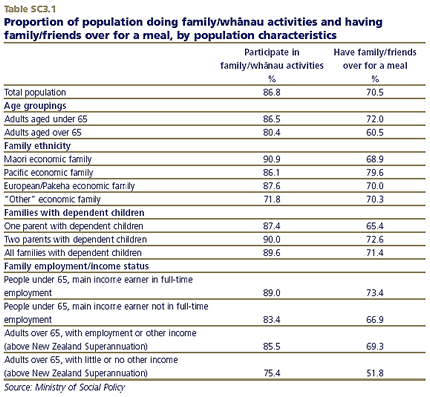
ETHNIC DIFFERENCES
According to the surveys, people living in Māori economic families are the most likely to take part in family or whānau activities (91 per cent), while Pacific and European/Pākehā people have average levels of participation (86 and 88 per cent, respectively). Those living in "Other" economic families are much less likely than average to take part in such activities (72 per cent), perhaps reflecting the fact that this group may include many new migrants whose families live overseas. Sharing meals in the home is more common among Pacific peoples (80 per cent) than among people of other ethnic groups (70 per cent).
AGE GROUP AND EMPLOYMENT OR INCOME DIFFERENCES
Adults over 65 years are less likely than average to engage in family/whānau activities (80 per cent) and considerably less likely to have people over for a meal (61 per cent), particularly those with no income other than New Zealand Superannuation (52 per cent). Among adults under 65, participation in family/whānau activities and sharing meals is somewhat lower than average where the main earner in the family is not in full-time employment (83 per cent and 67 per cent).
DIFFERENCES BY FAMILY TYPE
Not surprisingly, families with dependent children are more likely than average to participate in family/whānau activities, and there is little difference between sole parent and two parent families on this measure of social connectedness. However, sole parent families are less likely than two parent families to have friends or family over for a meal (65 per cent compared to 73 per cent).
Membership of and involvement in groups
DEFINITION
The proportion of the adult population (18 years and over) who are members of different types of community organisations and were "actively" or "passively" involved, as measured by the 1999 New Zealand Election Study. "Active" membership is defined here as having attended at least one meeting in the previous year; "passive" membership as having attended no meetings.
RELEVANCE
Participation in organisations and clubs is a measure of people's willingness to take part in activities outside the family, for their own enjoyment and for the benefit of others. Active participation provides opportunities for social interaction and support. It is widely regarded as a major source of social capital and a necessary component of a well-functioning, democratic society.
CURRENT LEVEL (TREND DATA NOT AVAILABLE)
In the 1999 New Zealand Election Study, more than two-thirds (70 per cent) of respondents said they belonged to an organisation, group or club. Sports clubs were the most often mentioned, with more than a third of respondents (38 per cent) reporting that they belonged to such groups. Other groups with high levels of membership were hobbies groups (31 per cent), church groups (30 per cent), unions or associations (28 per cent), social groups (28 per cent) and community services organisations (23 per cent).
For most types of group, members were more likely to be active than passive. Sports clubs, hobbies groups and churches had the highest proportions who had attended at least one meeting during the previous year. Members of youth groups, political parties and interest groups were least likely to have attended meetings during the year.
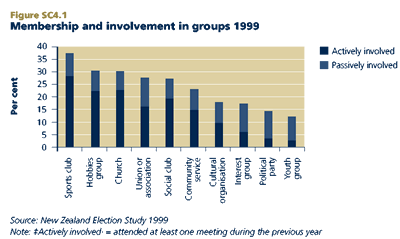
GENDER DIFFERENCES
The survey found substantial gender differences in group membership. Women were more likely than men to belong to church groups, hobbies groups and community services organisations, while men had higher membership of sports clubs and unions. A similar pattern held for active membership.
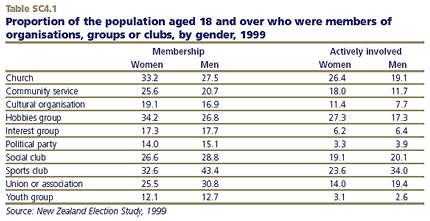
ETHNIC DIFFERENCES
According to the survey, Māori were much more likely than non-Māori to belong to sports clubs and cultural organisations, and slightly more likely to belong to social clubs. While non-Māori had higher levels of membership in community service organisations, political and interest groups, there was little difference between Māori and non-Māori in terms of active membership. Māori had higher active membership than non-Māori in church groups, cultural organisations, social clubs, sports clubs and youth groups. Nearly one in four Māori said they belonged to Māori organisations and almost all had attended at least one meeting during the previous year.
